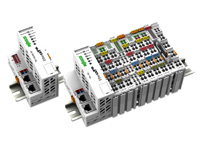EtherCAT Fieldbus Couplers for WAGO-I/O-System
With a fieldbus-independent design that features finely modular components, the WAGO-I/O-SYSTEM 750 is approved for extremely diverse applications. Optimized for process-oriented communication, the WAGO-I/O-SYSTEM 750 offers high integration density with an unbeatable price/performance ratio.
The basic premise of the modular system is reflected in the support of numerous fieldbus systems. Depending on the application, it is possible to choose between fieldbus couplers and controllers for different protocols.
The EtherCAT couplers 0750-354 and 750-354/000-001 allow the user to implement EtherCAT applications, while benefiting from the high flexibility of the WAGO-I/O-SYSTEM. The EtherCAT fieldbus couplers boast a very powerful data transfer capability. The WAGO-I/O-SYSTEM's couplers identifie the connected I/O modules and generates data for the relevant application. During EtherCAT telegram processing, only the coupler's relevant data is extracted from the telegram, while the required process data is being completed by the coupler.
A special EtherCAT communication unit, consisting of an EtherCAT slave controller (ESC), controls the entire process data exchange with the EtherCAT master. High transmission speed and data exchange reliability is provided by transferring lower communication levels into hardware. Both mailbox as well as cyclic and acyclic data can be transmitted and processed via CoE (CAN application protocol over EtherCAT). Easy and time-saving commissioning of the fieldbus coupler is achieved via automatic address assignments and EDS file integrated into the engineering tool of the EtherCAT master. Both line-in and line-out RJ-45 connectors are located on the front of the coupler, providing easy configuration of line structures.
The device ID for the new EtherCAT fieldbus coupler 750-354/000-001 can be permanently assigned via switch. By defining the explicit device ID via address switch, the EtherCAT fieldbus coupler always retains its set device ID - regardless of its position on the EtherCAT bus. This method of address allocation is markedly less restrictive than other more simple methods in which all bus nodes are numbered consecutively according to their location (order) on the fieldbus: Changes within network configuration are not necessary because address changes no longer occur via rewiring.
Both EtherCAT couplers are Conformance-tested and underline therefore the implementing quality.



